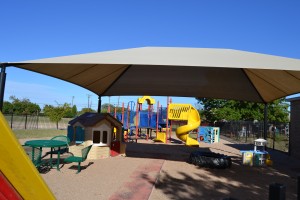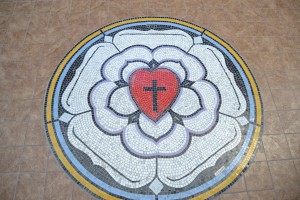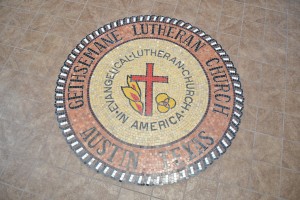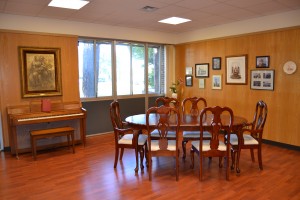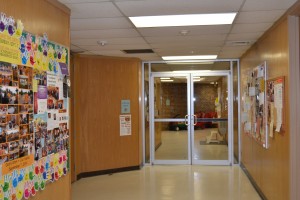Gethsemane Lutheran Church
Constructed in 1962, the Gethsemane Lutheran Church sanctuary was built on 10 acres of land purchased in 1960 that had been previously used as a cotton field. The new Gethsemane Lutheran Church serves as the replacement for The Swedish Evangelical Lutheran Church at 16th and Congress, now a historical landmark. The architectural design of the church is Gothic in concept and contemporary in design. Extensive stained glass work enhances the incredible beauty and uniqueness of the entire church while giving focus to the sanctuary.
Exterior 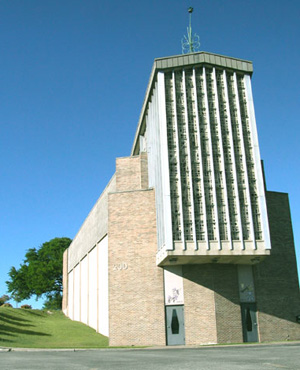
Lower Level Entrance
to the Church Office, Meeting/Music Room, Altar Guild, Gethsemane Clothes Closet & Food Pantry Entrance consists of 2 separated doors which lead into the lower level sanctuary hall.
Lower Level Entrance Mosaics
There are 2 tile mosaics above the lower level entrance which represent and refer to bible scriptures. There are 3 more mosaics just inside the main entrance.
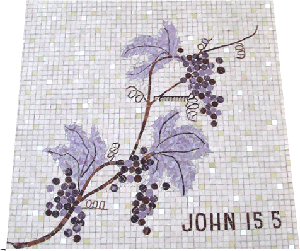 |
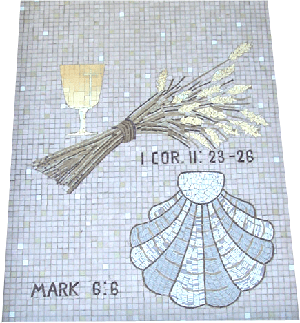 |
Main Entrance
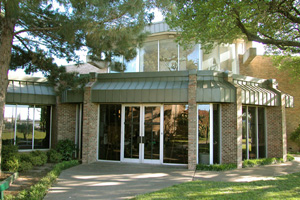
Open Space
On the 10 acre campus, there is plenty of open room outside to run, play, fly kites, or have quiet time for prayer and reflection.
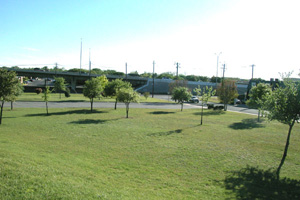 |
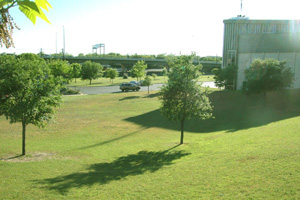 |
Gethsemane Memorial Garden
Near the main entrance on the east side of the entrance area are doors leading out to the small garden with a statue, a cross mounted on the wall, fountain and benches. It’s a great place to go quiet moments.
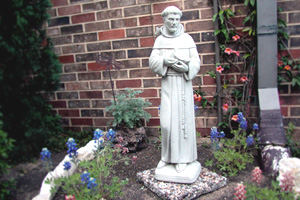 |
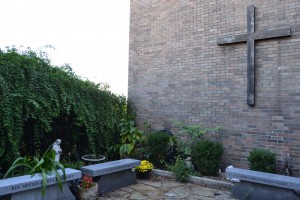
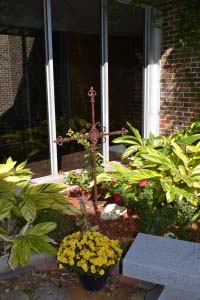
Educational Wing
The education wing extends outside to include 4 playgrounds and the Children’s Ministry. The education wing is dedicated as the Keith Leslie Johnson Memorial Education Wing in memory of the building committee chairman.


Sanctuary
The sanctuary is to the right once you’ve come into the main entrance. The padded pews angle slightly toward the altar. The sanctuary has a very peaceful atmosphere and is certainly a work of art bathed in the light of the stained glass, and is daily open for prayer and meditation.
Stained Glass Windows
The stained glass windows in the sanctuary have a peaceful calming affect as the sun shines through them. Beautiful colors spray through-out the sanctuary as the light refracts through the glass onto the walls and floors.
Pipe Organ / Balcony Seating

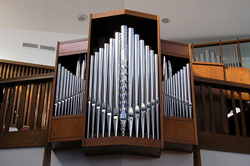
On December 12, 1868, the first Swedish Lutheran liturgy was held in Austin, Texas. After that worship, Swante Palm, a scholar and later the Swedish vice-consul, was chosen as chairman. “We love to sing our inspirational hymns and therefore I want to say that we can easily secure a melodeon or small organ which some member of the congregation can play. There are those among us willing to serve as organist. It is our love of the old hymns that prompts me to mention this matter. An organ may be obtained at a nominal price, if not by actual gift.” By November 1900, Gethsemane Lutheran’s organist, Swante Palm was utilizing a small pipe organ purchased from the Hinner and Albertson Co. of Peking, Illinois. In June 1951, a second pipe organ was purchased from the Wicks Company of Highland, Illinois. In 1963, the organ was rebuilt and expanded after being moved to the current church. A great division of displayed pipe work was installed. In 1977, the instrument was expanded along with upgraded action and a new blower. Dedicated to the historical tradition of pipe organ music, in 1985, the congregation approved a major expansion. This step involved the purchase of a three manual Cassavant console, pipe work, the replacement of all wind-chests and mechanical components, additional pipes bringing the total to 1,763, addition of a Ruck Positiv on the balcony railing. The Gethsemane Memorial Pipe Organ consists of 38 ranks of pipe work. In 2002, a zimblesterm was added to give the beautiful sounds of chimes for worship.

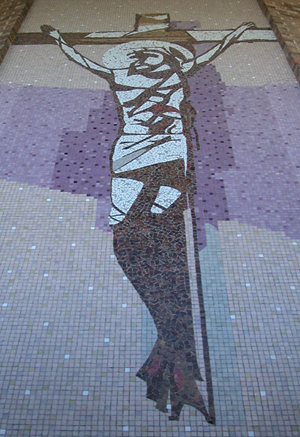

Main Entrance Mosaics
There are 3 mosaics of Jesus above the entrance doors to the sanctuary. The 3 mosaics represent Jesus helping, suffering, and then forgiving. These mosaics were on the exterior when the church was originally built.
Mosaic tile inlays at each Sanctuary entrance door created by Jose Blanco.
Steffans’ Parlor
From the hall to your left just as you enter the main entrance is a room with a comfortable home-like atmosphere where you can easily feel relaxed and welcome. It’s a nice place to gather or get away for quiet, and small groups and weekly Bible studies meet here.
Multi-Purpose Room, Kitchen & Cafeteria
The gym serves as a great inside recreation or event space which transforms into a large cafeteria once all the tables have been set out and the kitchen is opened. It’s put to good use.
Educational & Children’s Wing
The educational wing includes several classrooms teeming with fun and interesting things to look at, along with a nursery with plenty of cribs to set the babies to sleep in. At the end of the hall there’s an exit out into the playgrounds and Children’s Ministry building.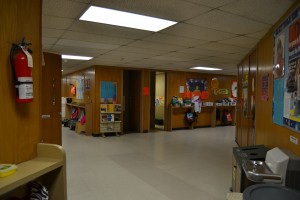
The Gethsemane Stained-Glass Windows
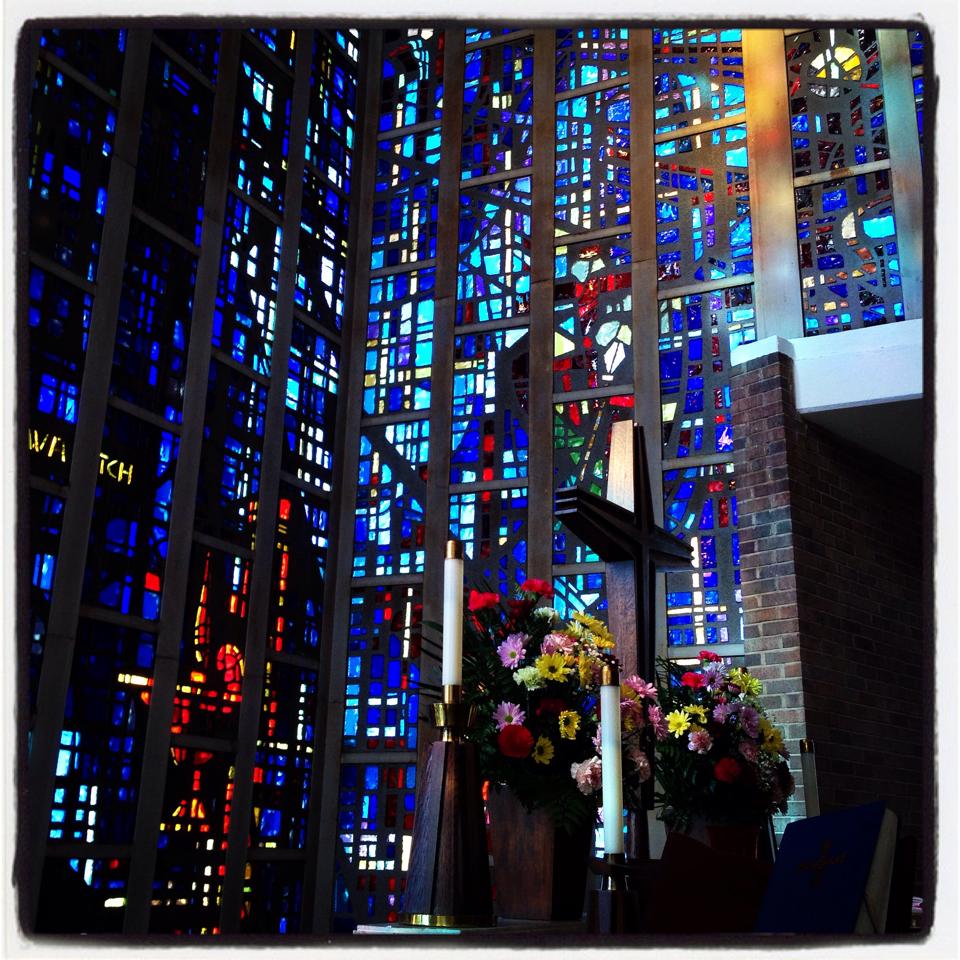

Gethsemane is identified as the beautiful stained glass church on highway 183 between Lamar and Interstate 35. Gabriel Loire of Chartres, France created the incredible stained glass windows of Gethsemane in order “to give a mystical atmosphere so that those who come have an experience of joy through peace with the window”. This world-renowned artist introduced the world to this unique style of glass. He received the French Legion of Honor award and his recognizable work is installed around the world. When Gabriel was ever sad, he would pull out the drawings of Gethsemane’s windows done by the children of Gethsemane and his spirit would be lifted.
Each panel was created in Loire’s studio in Chartres and reassembled on site like a giant puzzle. The windows utilize over 150 shades of Chartres’ blue with other colors for highlight effect in the windows and the light does wonderful movement. The windows form the globe of a lantern, hanging as “a lighthouse set on a hill“. The altar in the center is the light, declaring the gospel story to the people of God in Austin and throughout the world.
 The front wall is 40 feet tall and reflects the theme of Gethsemane with the hands of Christ in prayer and the words from the Garden of Gethsemane where Jesus spoke to his disciples in Mark 14, to tarry, watch, pray, and rise. The outline of the cross is visible. This magnificent piece sets the theme, A Heritage of Faith, for the chancel and clerestory windows.
The front wall is 40 feet tall and reflects the theme of Gethsemane with the hands of Christ in prayer and the words from the Garden of Gethsemane where Jesus spoke to his disciples in Mark 14, to tarry, watch, pray, and rise. The outline of the cross is visible. This magnificent piece sets the theme, A Heritage of Faith, for the chancel and clerestory windows.
Stained glass is the traditional way to tell the stories of the Bible and the church. Gethsemane’s windows tell the story from creation in the northeast corner through the Old Testament covenants and promises on the east side. The floor to ceiling windows on the east and west sides of the altar proclaim the story of Jesus from birth to resurrection. The west clerestory windows tell the story of the early Biblical church through the church of our day, living with the Spirit in acts of grace, to the final “alpha and omega” window at northwest corner.
Children and adults alike are amazed at the beauty of these fabulous spirit-filled windows. Gabriel Loire has completed over 850 beautiful works around the globe. Some of the outstanding works are Tower of Joy for Children in Hakone, Japan; the Kaiser Wilhelm Memorial Church in Berlin, Germany; Salisbury Cathedral, Salisbury, England; Thanksgiving Square, Dallas, Texas; Whatley Chapel, Denver, Colorado; Moody Memorial Methodist Church, Galveston, Texas; Chapelle du College de la Salle in Cairo, Egypt.

